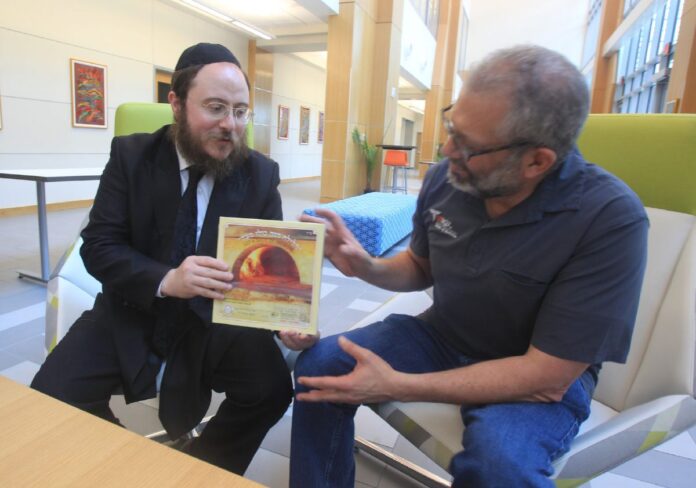EDINBURG — Janis Feldman, 69, associate professor of social work at The University of Texas Rio Grande Valley, remembers looking for the Afikoman (the hidden matzah) and participating in other Passover festivities as a young girl.
Matzah is a thin, crunchy form of unleavened bread that’s enjoyed along with other staple dishes during the Jewish Passover observance.
“Oh, wonderful,” Feldman said, describing the gefilte chicken her grandmother would prepare on Seder — the feast that marks the beginning of Passover. “All the smells in the house … we would all get excited looking for the Afikoman.”
Feldman was in the UTRGV Medical Education Building receiving a box of shmurah matzah from Rabbi Asher Hecht of Chabad Rio Grande Valley, as she and a group of faculty exchanged stories.
Shmurah matzah is unique in that it’s watched from the day the grain was harvested to the day the bread was packaged to make sure it made no contact with water. Other, store-bought, kosher-certified matzah found in local grocery stores only guarantee that the bread was prepared in the required 18 minutes.
Passover celebrates the Israelites’ freedom from slavery in Egypt. They left so quickly that their bread did not have time to leaven, which is why matzah is enjoyed at Passover.
“The universal meaning of Passover is that it’s time for redemption; you can actually liberate yourself … from the confines and limitation of life,” Hecht said.
Originally from New York, Hecht said while he was growing up, the resources to express his faith “in its highest, fullest standard,” were readily available. In the Valley, sometimes those resources are lacking, he said.
Hecht works to “fill those gaps” in the community. This Passover, he’s doing that by distributing shmurah matzah to the Jewish community throughout the Valley.
“This particular matzah that we deliver is not available in the Rio Grande Valley,” Hecht said. “The Valley has a beautiful Jewish community and there’s a strong passion here to keep traditions alive. But sometimes, because of where we’re located, what’s available sometimes in the larger cities, where there are large Jewish populations, we don’t have always available here.”
Per tradition, once they find the Afikoman (the hidden matzah), the children win a prize. In Feldman’s house, that was a dollar.
On Passover, it’s custom for the youngest children to ask questions about the holiday.
“That’s different than in the Latino community,” said Feldman, who was raised in Puerto Rico. “We’re taught from a young age to ask questions. In Latino culture, children don’t talk.”
Though, that’s not to say the two cultures don’t overlap, she said.
“It’s great to go to both parties (Latino and Jewish) together,” she said, with a chuckle. “I like to have my salsa and my Jewish Hora.”
“Both cultures hold on strongly to traditions,” said Eron Manusov, 60, a clinical associate professor at the UTRGV School of Medicine who was also present at the distribution on Tuesday.
Manusov, like Feldman, attends Chabad RGV with Hecht.
“It’s important to find that community,” he said. “We have one here (in the Valley) and it’s a very vibrant community.”
“There are certain foods that you eat that remind you of those times with your family,” he said. His personal favorite is matzah ball soup — which consists of matzah meal, eggs and spices — a recipe he said his wife has “perfected.”
Eventually, Feldman, Manusov and Hecht all left the building clenching their boxes of shmurah matzah, ready to celebrate the holiday.
The front of the box reads: “Get a taste of freedom.”




